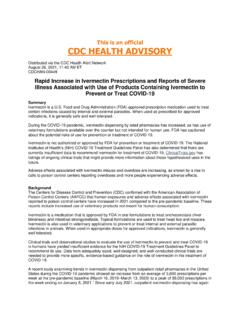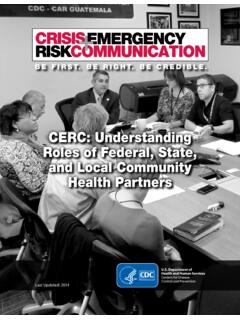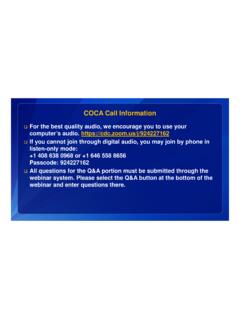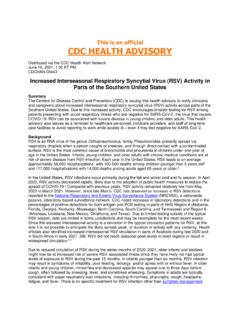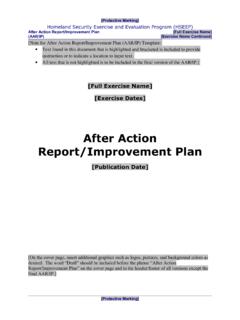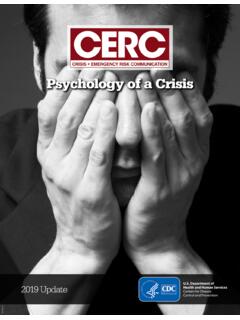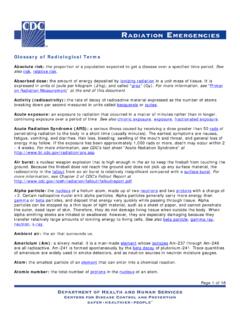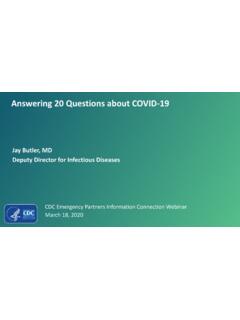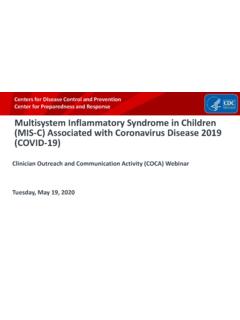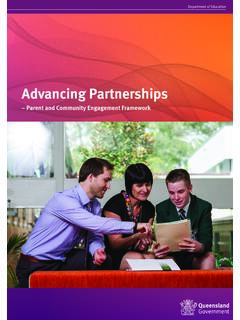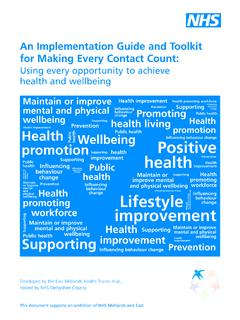Transcription of Introduction - CDC
1 1 CERC: INTRODUCTIONCERC: Crisis and Emergency Risk Communication Introduction 2018 Update CS 290397-A2 CERC: INTRODUCTIONCERC: Introduction This chapter will introduce: Crisis and Emergency Risk Communications (CERC)The Six Principles of CERCT erms Associated with CERCThe Phases of a Crisis and the Communication Rhythm The Role of CERCWhat is Crisis and Emergency Risk Communications (CERC)? The Centers for Disease Control s (CDC) Crisis and Emergency Risk Communication (CERC) manual provides an evidence-based framework and best practices for anyone who communicates on behalf of an organization responding to a public health CERC is built around psychological and communication sciences, studies in the field of issues management, and lessons learned from emergency responses. Emergencies can assault communities in an instant. Hurricanes, chemical releases, bombs, pandemic illness, and earthquakes are just some of the emergencies that we know could threaten any community at any time.
2 Often, communicating information is the first and only resource available for responders to give affected communities at the onset of an emergency. Through effective communication, we can impact how our community responds to and recovers from these potentially devastating emergencies. For the purpose of this manual, the term emergency describes any public health event or incident presenting risk to life, health, and infrastructure including natural, weather-related, and manmade destruction, infectious disease outbreaks, and exposure to harmful biological, radiological, and chemical agents. The term emergency encompasses crises and disasters. Why is CERC important? The right message at the right time from the right person can save lives. Barbara Reynolds, PhDCDC Senior Crisis and Risk Communication AdvisorWhen a crisis occurs, even if anticipated, initiating a full response can take time. The situation must be assessed and monitored for emerging or secondary threats, resources must be allocated, and personnel and materials must overcome any logistical or safety barriers to getting into the affected area.
3 But the affected people and those at immediate risk are ready to act right away and need information on the situation and how to stay safe CERC framework and its principles can help you provide the public with information to make the best decisions and to accept the imperfect nature of choice, under incredibly challenging time constraints. You can help your organization and your community prepare for, respond to, and recover from an emergency by using CERC s six main principles:2 be first, be right, be credible, express empathy, promote action, and show respect. We can have a real and measurable effect on the wellbeing of our communities by what we say, when we say it, and how we say it. 3 CERC: INTRODUCTIONThe Six Principles of CERC Throughout these chapters, six principles of effective emergency and risk communications are emphasized: 1Be First: Crises are time-sensitive. Communicating information quickly is crucial. For members of the public, the first source of information often becomes the preferred source.
4 2Be Right: Accuracy establishes credibility. Information can include what is known, what is not known, and what is being done to fill in the gaps. 3Be Credible: Honesty and truthfulness should not be compromised during crises. 4 Express Empathy: Crises create harm, and the suffering should be acknowledged in words. Addressing what people are feeling, and the challenges they face, builds trust and Action: Giving people meaningful things to do calms anxiety, helps restore order, and promotes some sense of 6 Show Respect: Respectful communication is particularly important when people feel vulnerable. Respectful communication promotes cooperation and rapport. Fully integrating CERC helps ensure that limited resources are managed well and can do the most good at every phase of an emergency response. 4 CERC: INTRODUCTIONT erms Associated with CERC Crisis Communication The term crisis communication describes the process of providing facts to the public about an unexpected emergency, beyond an organization s control, that involves the organization and requires an immediate response.
5 The crisis may cause harm to an organization s reputation or viability. Confronted with the uncertainty of this type of situation, crisis communicators must find a way to inform and alert the public about an emergency. The content, form, and timing of crisis communication can either help reduce and contain harm or make the situation worse. Communicator: Member of the organization impacted by the crisisTime pressure: Urgent and unexpectedMessage purpose: Explain and persuadeIssues Management Communication Issues management communication is similar to crisis communication except the organization has foreknowledge of the impending crisis and the opportunity to choose when they will announce the issue and reveal the organization s plan to resolve the : Member of the organization impacted by the crisisTime pressure: Anticipated; timing is somewhat controlled by the communicatorMessage purpose: Explain and persuadeRisk Communication Risk communication provides the community with information about the specific type (good or bad) and magnitude (strong or weak) of an outcome from an exposure or behavior.
6 Typically, risk communication is a discussion of a negative outcome and the probability that the outcomes will occur. Risk communication can be employed to help an individual make a choice about a behavior such as smoking, getting vaccinated, or undergoing a medical treatment. Communicator: Expert who is not directly impacted by outcomesTime pressure: Anticipated with little or no time pressureMessage purpose: Empower decision-making5 Risk Communication: Addressing Hazard and OutrageIn CERC, hazard can be explained as the amount of physical, structural, and economic damage caused by an event. Outrage is the level of emotion, concern, and even fear, anxiety, and anger brought on by an event or threat. Good risk communication aims to keep outrage in proportion to hazard so people will have the appropriate level of concern to motivate them to act according to the actual danger they face. More information about hazard, outrage, and risk is found in Psychology of a Crisis.
7 Crisis and Emergency Risk Communication (CERC) CERC encompasses the urgency of crisis communication, empowers decision-making, and is communicated by an expert that may be a an emergency, decisions about risks and behaviors must be made within a narrow timeframe. The decision may be irreversible; the outcome of the decision may be uncertain. The decision may need to be made with imperfect or incomplete information. Emergency risk communication can be used to help an individual make a decision in response to many questions, including the following: 1. Should I seek medical treatment?2. Do I need to treat my drinking water?3. Should I evacuate my home?4. Should I keep my child home from school?CERC combines the need to communicate about risks and benefits to your community under urgent time constraints. You can use CERC to provide information to guide individuals or entire communities to make the best possible decisions about their well-being during an : Expert who is impacted by outcomesTime pressure: Urgent and unexpectedMessage purpose: Explain, persuade, and empower decision-making 5 CERC: INTRODUCTIONC ommunication TypeCrisis CommunicationIssues Management CommunicationRisk CommunicationCrisis and Emergency Risk CommunicationCommunicatorMember of the organization impacted by the crisisMember of the organization impacted by the crisisExpert who is not directly impacted by outcomesExpert who is impacted by outcomesTimingUrgent and unexpectedAnticipated; timing is somewhat controlled by the communicatorAnticipated with little or no time pressureUrgent and unexpectedMessage PurposeExplain and persuadeExplain and persuadeEmpower decision-makingExplain, persuade, and empower decision-making.
8 The Phases of a Crisis and the Communication Rhythm Every emergency, disaster, or crisis evolves in phases. Communication efforts and priorities align with these phases, and communicators need to adapt and respond according to each phase. By dividing the crisis into the these phases preparation, initial, maintenance, and recovery communicators can anticipate the information needs of the media, government organizations, private and public organizations, and the people in an affected area. For each of these phases, specific types of information need to be created. Although some communication tactics change through the phases of the crisis communication rhythm, communicators need to maintain three objectives throughout all phases: community engagement , encouraging decision-making, and evaluation. community engagement : Include members of your community and local leaders ( , religious leaders, trade union officials, representatives from community based-organizations, etc.)
9 In planning for and responding to an emergency. Consider them in decisions, gather feedback, and respond to their needs. Provide two-way communication and engage in active listening. (See more on community engagement ). Empower decision-making: Public health leaders and communicators can guide community members to make their own decisions by providing information about the situation, risks, resources available, and actions they can take. Give options for communities to decide on their own, what is in their best interest. (See more on community engagement ). Evaluation: Evaluating a response does not just occur in a formal after-action review; throughout a response, gather feedback and test audience understanding of your messages. An important component of the maintenance phase is to tailor messages for specific audiences. Evaluating the reach of your messages and assessing who is taking action and where there are information gaps can help save more lives during a response.
10 It s too late after. 6 CERC: INTRODUCTIONF igure 1-1. Crisis and Emergency Risk Communication (CERC) RhythmAccessible information for figures is located in Appendix, page 11. PreparationDevelop partnerships and build relationships with organizations and community stakeholders that you expect to work with in a organizations that represent different segments in your community , and connect with them before an emergency. Establish shared concerns for your target populations so you can connect and empathize with their communities. Identify roles and processes for you and your partners to distribute information during an emergency. Draft and test messages with different populations to make sure that the information is understandable and actionable in a draft messages and communication products like infographics, social media messages, and flyers out to community groups or community representatives for feedback on content and delivery. Ensure messages are easily understood and will motivate the intended actions.
